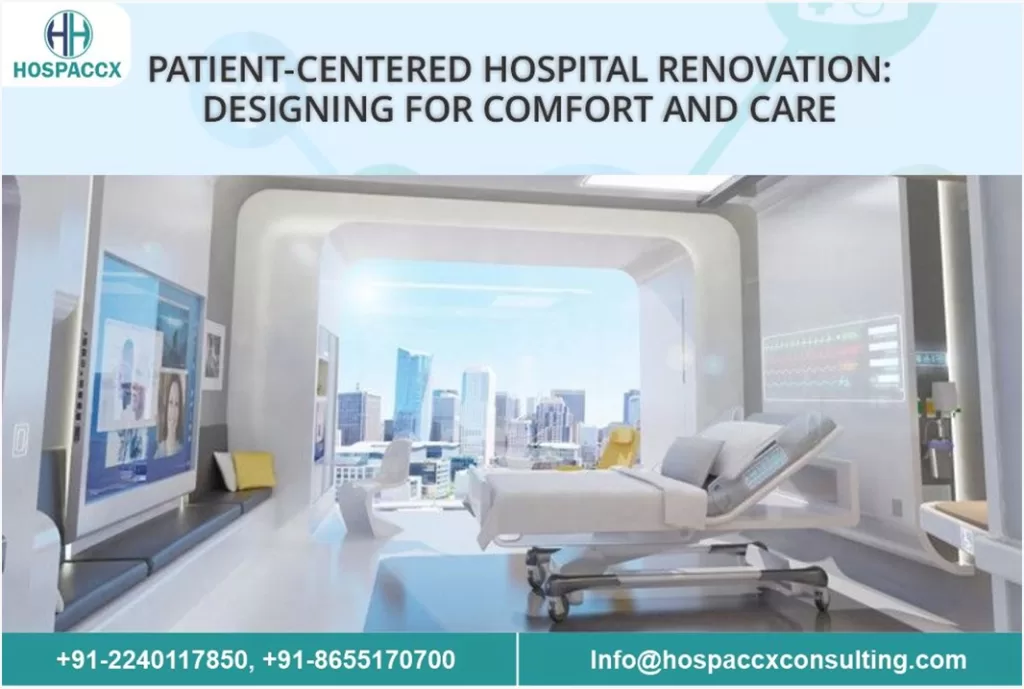By Hospaccx Healthcare Business Consulting
Hospital renovations have historically focused on upgrading technology, improving operational functionality, and ensuring compliance with regulatory standards. While these elements remain essential, an increasing number of healthcare facilities are now shifting their focus to patient-centered design. This approach emphasizes creating environments that prioritize the physical, emotional, and mental well-being of patients, ultimately enhancing the overall care experience.
In this blog post, Hospaccx Healthcare Business Consulting explores the importance of patient-centered hospital renovations and how thoughtful design can foster healing, comfort, and a positive experience for patients, families, and staff alike.
What is Patient-Centered Design?
Patient-centered design takes a holistic approach to hospital renovation, focusing on the needs, preferences, and comfort of patients throughout their care journey. This design philosophy goes beyond clinical needs, acknowledging the emotional and psychological aspects of healing. By creating environments that reduce stress and promote well-being, hospitals can enhance patient satisfaction, improve recovery rates, and offer a more compassionate healthcare experience.
Key Elements of Patient-Centered Hospital Renovation
Private and Comfortable Patient Rooms
The design of patient rooms is one of the most important aspects of patient-centered renovations. Traditional hospital rooms are often clinical, impersonal, and cramped. In contrast, patient-centered rooms are designed with comfort and privacy in mind. These rooms are spacious, with plenty of natural light and noise-reducing materials, creating a relaxing, home-like atmosphere.
Design Features:
- Spacious rooms with abundant natural light
- Comfortable furniture and noise reduction elements
- Private spaces for both patients and their families
Benefits:
- Patients feel more comfortable and at ease, fostering better recovery
- A sense of control over the environment leads to improved satisfaction
- Reduced stress and anxiety in a comfortable setting
Access to Nature and Outdoor Spaces
Exposure to nature has been shown to have therapeutic effects, improving both physical and mental health. Hospital renovations that incorporate gardens, courtyards, or green roofs offer patients a tranquil retreat. Additionally, integrating views of nature into patient rooms and common areas can help reduce stress, improve mood, and speed up recovery.
Design Features:
- Landscaped gardens and therapeutic walking paths
- Patient rooms with views of greenery or outdoor spaces
Benefits:
- Faster recovery and reduced stress
- Increased satisfaction for both patients and their families
- A peaceful environment that enhances emotional well-being
Quiet Zones and Healing Environments
Hospitals can often be noisy environments, which can hinder healing and disrupt sleep. By incorporating quiet zones and soundproofing elements into the renovation, hospitals can create spaces conducive to rest and recovery. These areas provide much-needed tranquility for patients, family members, and staff.
Design Features:
- Soundproofing and noise-reducing materials
- Designated quiet rooms for patients and families
- Separate areas for staff to avoid disturbing patients
Benefits:
- Improved sleep quality and reduced stress
- A calmer, more restful environment conducive to healing
- Enhanced patient satisfaction
Enhanced Lighting
Lighting is crucial in creating a healing environment. Poor or harsh lighting can disrupt circadian rhythms and make it difficult for patients to relax and recover. Patient-centered renovations focus on maximizing natural light and providing adjustable lighting that can be tailored to the needs of each patient.
Design Features:
- Large windows for ample natural light
- Adjustable lighting for patient comfort
- Ambient lighting that promotes calmness
Benefits:
- Enhanced mood and improved sleep quality
- Better control over the environment for patients
- A soothing atmosphere that aids recovery
Family-Centered Design
Family plays a crucial role in a patient’s healing process. Renovations that include family-friendly features, such as overnight accommodation options and private spaces for consultations, help support families as they provide emotional and physical care for their loved ones.
Design Features:
- Pull-out beds or family lounges for overnight stays
- Private consultation spaces for family discussions
- Quiet areas for family support and counseling
Benefits:
- Strengthened family involvement in the patient’s recovery
- Reduced family stress and enhanced support networks
- A more compassionate environment for patients and their families
Supporting Staff Efficiency and Patient Care
Patient-centered renovations must also consider the needs of healthcare staff. Efficient design that streamlines workflows and reduces unnecessary movement can help improve staff response times and care delivery. A well-organized environment allows healthcare professionals to provide better patient care.
Optimized Workflow
Well-designed layouts that optimize staff workflow are essential for providing high-quality patient care. This includes designing nurse stations, treatment areas, and medical supply storage to ensure that healthcare professionals can respond quickly to patients.
Design Features:
- Centralized nurse stations
- Logical placement of medical equipment and supplies
- Clear signage to guide staff and patients
Benefits:
- Improved response times and faster patient care
- Reduced staff stress and better operational efficiency
- Easier access to essential equipment
Smart Technology Integration
The integration of smart technology into hospital renovations can significantly enhance both patient care and staff efficiency. From electronic health records (EHR) to interactive bedside tablets, technology can improve communication, streamline operations, and provide patients with greater control over their environment.
Design Features:
- Remote patient monitoring tools and telemedicine capabilities
- Touch-screen controls for room settings
- In-room video consultations and entertainment systems
Benefits:
- Improved patient engagement and satisfaction
- More efficient care coordination
- Enhanced communication between staff and patients
Healing Through Art and Aesthetics
Art has long been recognized for its therapeutic effects, particularly in hospital settings. By incorporating art installations, murals, and calming color schemes, hospitals can create inviting environments that promote healing and reduce anxiety.
Design Features:
- Murals and art pieces in waiting areas and patient rooms
- Calming color schemes and interactive art displays
Benefits:
- Enhanced emotional well-being and reduced anxiety
- A more positive atmosphere for both patients and staff
- Improved patient satisfaction and engagement
Improving Patient Privacy and Dignity
Respecting patient privacy is a fundamental aspect of patient-centered care. Renovating hospitals to include private rooms, soundproofing, and confidential consultation areas helps maintain dignity and fosters trust in healthcare providers.
Design Features:
- Enclosed rooms with soundproofing
- Private spaces for consultations and treatments
Benefits:
- Increased patient trust and satisfaction
- Greater respect for individual privacy
- Enhanced comfort and dignity during care
Collaborating with Patients and Families During Renovation
Involving patients and families in the renovation process can provide valuable insights that guide design decisions. Hospitals can use surveys, focus groups, and one-on-one interviews to gather feedback and incorporate patient preferences into the renovation plan.
Approach:
- Collect feedback through surveys and focus groups
- Involve patients and families in mock-up testing
- Use patient input to refine design concepts
Outcome:
- Renovations that better reflect the needs and desires of patients and families
- A more personalized and empathetic healthcare environment
The Long-Term Benefits of Patient-Centered Renovation
Improved Patient Outcomes
A patient-centered environment can lead to better clinical outcomes. Research shows that such spaces reduce stress, improve mood, and speed up recovery times, particularly after surgery or in the treatment of chronic conditions.
Higher Patient Satisfaction
Patients who feel cared for and respected are more likely to have positive experiences and return to the hospital for future care. High patient satisfaction can also enhance the hospital’s reputation and foster trust in the community.
Enhanced Staff Satisfaction
A hospital environment designed with patient-centered care in mind benefits staff as well. A comfortable, organized space contributes to staff satisfaction and engagement, leading to better performance and lower turnover rates.
Conclusion
Patient-centered hospital renovations go beyond mere upgrades—they represent a commitment to enhancing the overall healthcare experience. By prioritizing comfort, privacy, and healing, hospitals can create environments that support patients and their families at every stage of care. Thoughtful renovations that incorporate these principles improve clinical outcomes, foster patient satisfaction, and enhance the well-being of both patients and staff.
Hospaccx Healthcare Business Consulting specializes in designing patient-centered healthcare environments that support healing, improve patient care, and enhance operational efficiency. With a deep understanding of healthcare facility design, we help hospitals create spaces that prioritize comfort, privacy, and functionality.
For expert consultation on patient-centered hospital renovations, visit Hospaccx Healthcare Business Consulting.
For more insights on hospital design and patient care, subscribe to our blog!
#PatientCenteredCare #HospitalRenovation #HealthcareDesign #HealingEnvironment #PatientExperience #Hospitals #HealthcareConsulting #FacilityDesign #PatientPrivacy #HealingThroughDesign #HealthcareInnovation #Hospaccx
Related Team Members




















